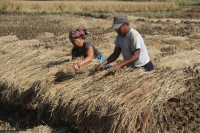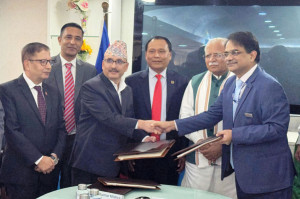Money
Caan, Army to sign accord for Nijgadh airport project
The Civil Aviation Authority of Nepal (Caan) has decided to assign the Nepal Army to build access and perimeter roads and clear trees at the proposed construction site of Nijgadh International Airport in Bara. A memorandum of understanding (MoU) is to be signed next week.
The Civil Aviation Authority of Nepal (Caan) has decided to assign the Nepal Army to build access and perimeter roads and clear trees at the proposed construction site of Nijgadh International Airport in Bara. A memorandum of understanding (MoU) is to be signed next week.
A draft MoU jointly prepared by Caan and the Nepal Army has been submitted to their respective line ministries for approval. It was reviewed by a high-level committee comprising officials from the Defence and Environment ministries, Nepal Army and Caan that had been constituted to assist the project, particularly with regard to the construction of an access road and forest clearance.
“We are all set to sign the MoU to entrust the preparatory work at the Nijgadh International Airport project to the Nepal Army following widespread criticism over delays in starting construction,” said Sanjiv Gautam, director general of Caan.
The government has allocated a budget of Rs1.5 billion for the project for this fiscal year, and Caan has set aside another Rs3 billion to pay for initial works if required, said Gautam.
The government had announced inviting tenders for the construction of the airport by this fiscal year while presenting the budget statement for fiscal 2017-18 to Parliament.
The project envisions building a large-scale modern airport in Nijgadh in Bara district, 175 km from Kathmandu in the southern plains. It will be the country’s second international airport after Tribhuvan International Airport (TIA).
The proposed facility in Nijgadh will be the biggest in South Asia in terms of area once it is completed.
Meanwhile, the government is scheduled to conduct public hearings on August 31 with locals and stakeholders concerned about the impact of the project.
The project has prepared a draft Environment Impact Assessment (EIA) report, and it will be made public as it should include their comments and address their grievances, said Hari Adhikari, chief of the project. “After that, the final report will be produced.”
After the report is prepared, it will be submitted to the Environment Ministry for its approval, Adhikari said. “We will act as per the instructions of the Environment and Forest ministries.”
Caan has hired a consultant to carry out an environmental and social impact assessment of the area where the airport is being built. Nearly 90 percent of the proposed construction site is covered by Shorea robusta trees, also known as Sal or Sakhua.
The preliminary EIA report shows that more than 2.4 million small and large trees will have to be cut down to build the long-awaited modern international airport in Nijgadh. The market value of the lumber stands at over Rs65 billion, according to sources privy to the matter. The money from the sale of trees will pay for half of the construction cost, officials said.
The planned construction site lies amid dense forest and will be spread over 8,000 hectares. However, in the first phase, the airport will have only one runway and occupy 1,000 to 2,000 hectares. The infrastructure will be expanded gradually based on need, the report said.
On February 10, the Forest Ministry allowed the Tourism Ministry to conduct an EIA on the condition that the project’s executing agency plant 25 saplings for every tree that is cut down. The Forest Ministry has also asked the Tourism Ministry to prepare an economic valuation of the impact of the airport construction project on biodiversity.
Caan has estimated that the proposed second international airport in Nijgadh can be constructed at a cost of Rs121 billion, excluding the proposed airport city.
A preliminary internal financial assessment conducted by Caan has proposed building a 4,000-metre runway. Likewise, Caan has proposed building a 100,000-square metre international passenger terminal building. Caan said the airport would be able to handle 20 million passengers annually in the first phase.




 24.12°C Kathmandu
24.12°C Kathmandu














